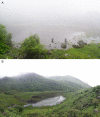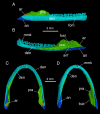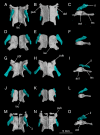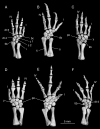Osteology of Batrachuperus yenyuanensis (Urodela, Hynobiidae), a high-altitude mountain stream salamander from western China
- PMID: 30682102
- PMCID: PMC6347256
- DOI: 10.1371/journal.pone.0211069
Osteology of Batrachuperus yenyuanensis (Urodela, Hynobiidae), a high-altitude mountain stream salamander from western China
Abstract
Batrachuperus yenyuanensis, commonly known as Yenyuan Stream Salamander, is a hynobiid species inhabiting high-altitude (2440-4025 m above sea level) mountain stream and pond environments along the eastern fringe of the Qinghai-Tibetan Plateau in western Sichuan Province, China. Although the species has been known for almost 70 years since its initial discovery in 1950, a thorough osteological description has never been provided. Our study provides a detailed account of the bony anatomy of this species, based on micro computed tomography scanning of multiple specimens collected from the type locality Shuangertang at Bailinshan, Yanyuan County, and several other localities in Sichuan Province. Our revised species diagnosis utilizes both bony and soft anatomical features. Comparative study of the specimens from the type locality in Yanyuan area with those from the nearby Xichang and Mianning areas confirms that they all pertain to Batrachuperus yenyuanensis, thereby removing doubt on the occurrence of the species in the latter areas. With this confirmation, the distribution of the species is extended from the type locality northwards some 180 km to the Mianning area, on both the west and east sides of the Yalong River, which is a major tributary of the upper Yangtze River. This distribution pattern indicates that the biogeographic origin and historical evolution of the species are closely associated with the orogeny of the Hengduan Mountains and formation of the Yalong River. Given the basalmost position of Batrachuperus yenyuanensis in relation to other congeneric species based on molecular studies, however, early expansion of the species distribution by dispersal is expected following the origin of the genus in early-middle Miocene in western Sichuan Province. Thus, the species may well have achieved its current distribution in western Sichuan before the drastic uplift of the Qinghai-Tibetan Plateau in Pliocene.
Conflict of interest statement
The authors have declared that no competing interests exist.
Figures














References
-
- Dunn ER. The sound-transmitting apparatus of salamanders and the phylogeny of the Caudata. American Naturalist. 1922; 56: 418–427. 10.1086/279882 - DOI
-
- Duellman WE, Trueb L. Biology of amphibians New York: McGraw-Hill Book Company; 1986.
-
- Frost DR, Grant T, Faivovich J, Bain RH, Haas A, Haddad CFB, et al. The Amphibian Tree of Life. Bulletin of the American Museum of Natural History. 2006; 297: 1–370.
-
- AmphibiaWeb: Information on amphibian biology and conservation Berkeley, California: AmphibiaWeb; Available: http://amphibiaweb.org/. Accessed 9 March 2017.
-
- Frost DR. 2018. Amphibian species of the world: an online reference. Version 6.0. 2018. 2018. American Museum of Natural History, New York, USA. Available: http://research.amnh.org/herpetology/amphibia/index.html. Accessed 9 April, 2018.
Publication types
MeSH terms
LinkOut - more resources
Full Text Sources

